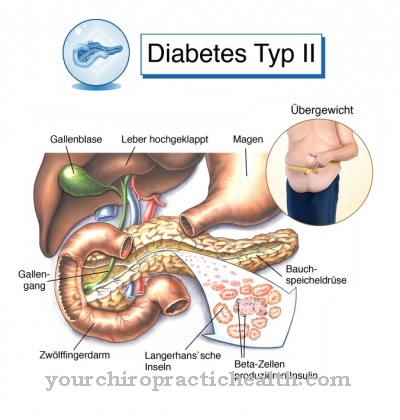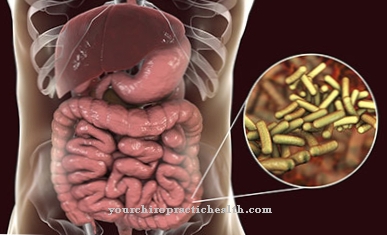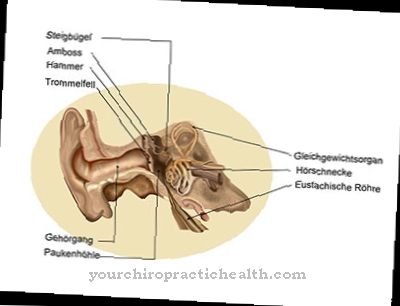A Tracheomalacia is a comparatively rare disease that is associated with instability or softness of the windpipe (trachea) and can be traced back to congenital (innate) and acquired causes. The prognosis and course of tracheomalacia depend on the underlying cause.
What is tracheomalacia?

© SciePro - stock.adobe.com
As Tracheomalacia is an instability of the trachea, which is caused by insufficient strength of the cartilage braces stabilizing the trachea and which can affect individual sections or the entire trachea.
As a result of the softness of the tracheal cartilage structures, breathing can be impaired as the breathing resistance is increased. Due to the greatly reduced negative inspiratory pressure when inhaling, this can also lead to a collapse of the trachea, especially when there is an increased need for oxygen.
Tracheomalacia manifests itself in the form of an inspiratory and expiratory stridor (secondary breathing noises when breathing in or out), restricted resilience, functional stenosis (narrowing), cough, tachy- and dyspnea (increased or difficult respiratory function) and cyanosis.
Affected infants also often overextend their necks in order to widen the lumen of the trachea (so-called opisthotonus position). As the disease progresses, the impairment can spread to the bronchi (tracheobronchomalacia).
causes
Depending on the underlying cause, there are three types of Tracheomalacia differentiated. In the congenital or primary form, there is usually a congenital connective tissue disease such as kampomelia syndrome, esophageal atresia (malformation of the esophagus) or tracheoesophageal fistulas, which lead to impaired growth of the tracheal cartilage.
In addition, tracheomalacia can be caused by external compression (type 2), which narrows the trachea. The narrowing (stenosis) is typically due to mediastinal tumors (including hemangioma), congenital vascular anomalies (including double aortic arch, so-called pulmonary loop), bronchogenic cysts, a megaesophagus or a goiter.
The third form is caused by chronic infections (including recurrent polychondritis) or excessively long intubation with high ventilation pressures, with an increased risk here, especially in premature babies.
Symptoms, ailments & signs
Tracheomalacia leads to breathing difficulties and an abnormal breathing sound. Doctors differentiate between congenital and acquired tracheomalacia. The innate expression is usually associated with a positive outcome. It is no longer present after the first or second year of life even without therapy.
Symptoms are most common in prone patients. There is an improvement in an upright or inclined position. Clear signs can be detected when inhaling. Then the resistance of those affected is comparatively greater. Doctors listen to the breathing as part of their diagnosis and usually describe the noise as a chicken cackling.
At the same time, the nostrils move with the inhalation and exhalation, which is often hidden from the sick. Pendulum movements can occur in the abdomen. Sick children and adults are often unable to ascertain the named symptoms themselves. That is why the consultation of a doctor is essential.
If those affected identify problems in advance, they affect breathing. Often reference is made to problems in stressful situations. Breathlessness quickly sets in when exercising or when walking in pronounced gaits. Affected people then react with a cough and gasp for air. Fear and panic also arise regularly.
Diagnosis & course
A first suspicion of one Tracheomalacia often results from clinical symptoms. A decrease in air flow during expiration (exhalation) as part of a lung function check also indicates the possible presence of tracheomalacia.
In addition, a functional stenosis due to a tracheomalacia can be distinguished from a fixed tracheal stenosis. The diagnosis is confirmed by a fiber-optic endoscopy, which enables an assessment of the dynamic changes in the tracheal lumen in the various respiratory phases. Diagnostic imaging methods such as MRI (magnetic resonance imaging), CT (computed tomography) or angiography can detect tracheomalacia as a result of external compressions. The course and prognosis of tracheomalacia strongly depend on the underlying cause.
While congenital forms usually have a very good prognosis and are largely self-emitting, the infection-related form has a significantly less favorable prognosis. The prognosis of other acquired forms of tracheomalacia depends on whether the triggering factors (tumors or malformations) can be eliminated.
Complications
The breathing difficulties typical of tracheomalacia can cause various complications as the disease progresses. Initially, there may be difficulty breathing. As a result, there is an insufficient supply of oxygen to the brain, which can have life-threatening consequences, especially for infants and small children.
With a strong tracheomalacia, which is also aggravated by infections, there is an acute risk of suffocation. Complications can also arise from the underlying disease. For example, if the tracheomalacia is based on a tumor, there is always the risk that it will metastasize or enlarge and make breathing difficulties worse.
If the course is severe, the prognosis is rather poor. Many children die of the disease or suffer from stunted growth and mental disorders due to the lack of oxygen. The drug treatment is an enormous burden for infants and young children. An overdose can quickly lead to serious complications, and side effects can also occur.
A surgical procedure carries the usual risks, i.e. the risk of infections, bleeding and nerve or vascular damage. Splinting the trachea is particularly problematic. Inflammation or sensitive injuries to the windpipe occur again and again. After an operation, wound healing disorders and secondary bleeding can also occur.
When should you go to the doctor?
General breathing difficulties are generally a cause for concern. If they occur in physically demanding situations or during sporting activities, they are often part of a natural reaction. As soon as the complaints recede within a short time when taking a rest phase, in most cases there is no further need for action. However, if the irregularities in breathing persist or if they increase in intensity, a doctor must be consulted.
Since this disease can be congenital or acquired, a doctor is needed as soon as newborns show the first abnormalities. If there are changes in breathing activity during the development and growth process or in adulthood, a doctor should also be consulted. A cough, a pale appearance and a decrease in physical performance are signs of a health disorder. In the event of fatigue, rapid exhaustion or fatigue, a cause research should be initiated.
Medical help is also required if the person concerned has emotional or mental peculiarities. A doctor should be consulted in states of uncertainty, fear and panic, a racing heart and sweating. If there is resistance in the body when breathing in oxygen, this is a characteristic feature of the disease and should be discussed with a doctor as soon as possible.
Treatment & Therapy
The therapeutic measures are attached Tracheomalacia on the extent, the underlying cause and the age of the specifically affected person. The congenital form is usually self-emitting and, due to growth, stabilization of the tracheal wall takes place in the first two to one and a half years of life.
Physiotherapeutic measures can help improve respiratory function. If secondary infections occur as a result of the increased retention of secretions, antibiotic therapy in combination with inhalations to moisten the airways may be indicated. In some cases, especially with diffuse tracheobronchomalacia or inadequate oxygen supply, long-term CPAP therapy (CPAP = Continuous Positive Airway Pressure) via a tracheal cannula or ventilation mask is recommended until the cartilaginous structures have been stabilized by growth.
Surgical intervention is indicated for severe or life-threatening forms and children who cannot be weaned from CPAP therapy. To avoid tracheal compression, the aorta is fixed to the sternum (breastbone) in the context of an aortopexy in the case of short-range tracheomalacias, so that the mediastinum (middle area) has more space. If the tracheomalacia is long, the trachea is splinted using an expandable intraluminal metal stent.
In addition, the triggering factors in acquired tracheomalacia should be eliminated. Compressive structures such as tumors, vascular abnormalities or goiter should be surgically removed. If, on the other hand, the tracheomalacia can be traced back to an infection-related instability, antibiotic therapy is indicated.
You can find your medication here
➔ Medicines for lung and bronchial ailmentsprevention
The congenital form of a Tracheomalacia can be prevented to a limited extent by treating the malformations that cause them as far as possible. Acquired tracheomalacia can be prevented by taking appropriate care with long-term intubation and consistent treatment of underlying diseases such as tumors or goiter.
Aftercare
Tracheomalacia is a relaxation of the windpipe, which can be justified by various causes. The follow-up care, which must focus on the underlying disease, is correspondingly diverse. In infants with congenital tracheomalacia, repositioning the child can often temporarily relieve the symptoms. If spontaneous healing occurs after some time, this does not require any special follow-up care in the further course, but only the regular presentation to a pediatrician, who ensures complete healing.
If tracheomalacia occurs as a result of external influences such as goiter, the causal disease must be treated and, as a rule, an operation must be carried out. Here, the follow-up care is designed for the underlying disease and can therefore not be presented as a single valid form. The consequences and aftereffects of the operation must be observed and the healing process accompanied.
The tracheomalacia and its healing must also be included in the follow-up care by an appropriate specialist. If the tracheomalacia was caused by an infectious trigger, acute treatment with antibiotics is necessary. In the follow-up care the specialist ensures the freedom from bacteria and the healing of the tracheomalacia. In addition, it must be noted that antibiotic therapy also affects the intestinal flora. This should be rebuilt in the aftercare.
You can do that yourself
Congenital tracheomalacia can be improved by lying the baby on the stomach for the first few months of life. This often leads to an improvement in the symptoms over the course of months to years. If the disease is based on external compression, the cause must be treated. This can be achieved, for example, through radio-iodine therapy or a strumectomy if the symptoms are based on a goiter. In addition, the typical general measures apply, i.e. rest and protection.
Tracheomalacia caused by an infection must be treated with medication, for example by taking antibiotics. The appropriate accompanying treatment is rest. Severe tracheomalacia can lead to life-threatening breathing difficulties. Good monitoring of the person concerned is all the more important. If the mentioned respiratory problems occur, the emergency doctor must be called. The patient must be placed in a stable lateral position so that adequate ventilation of the lungs is possible. Depending on the intensity and localization of the symptoms, tracheostomy tubes can then be laid to ensure the supply of oxygen. The tube must be checked for inflammation and bleeding, which occur mainly in people whose immune system is already significantly weakened by the disease.
Patients who suffer from tracheomalacia must be constantly monitored in everyday life, as complications can occur again and again. To ensure that help arrives quickly in the event of a medical emergency, close contact should be maintained with the emergency telephone service.





.jpg)







.jpg)

.jpg)
.jpg)











.jpg)